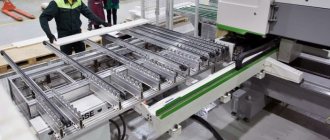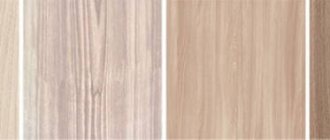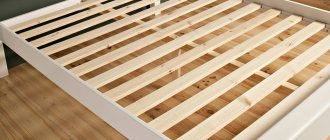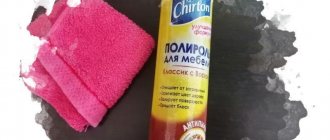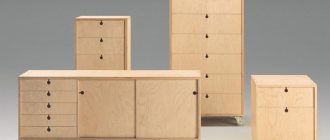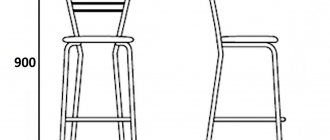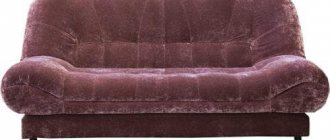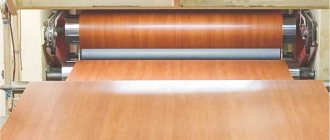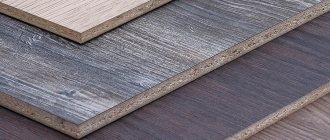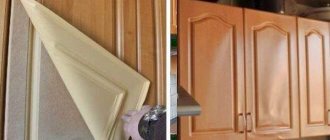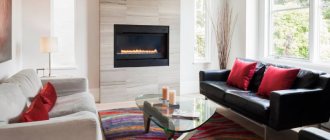Today, the market for repair and construction materials does not experience a shortage. Moreover, sometimes products with similar characteristics are offered, the consumer properties of which are quite difficult to understand. For example, both laminated particle board ("LDSP") and "Medium Density Fiberboard" ("MDF") - panels are excellent for wall cladding and are the main materials in the manufacture of furniture.
Moreover, in recent years, both of these products have been used not only in the production of economy-class furniture products, but have also carved out their niche in the “premium” segment. Despite the similarity in appearance of both types of construction and finishing products, there are significant differences between them that allow them to be used in some industries, while in others their use is undesirable.
However, before answering which of these two materials is better, in the production of which products it is better to use “chipboard”, and where “MDF” panels are more suitable, it is necessary to understand the raw materials that are used in manufacturing and the production technology.
What is "MDF"
The Russian abbreviation “MDF” is a transliteration of the English abbreviation “MDF” - “Medium Density Fiberboard”. According to the manufacturing technology, it is a medium-density wood fiber board produced by dry pressing. The starting component is fine wood shavings, which are pressed under high pressure and elevated temperature. Various types of urea or lignin (non-phenolic) resins modified with melamine are used as a binder.
A patent for the production of this building and finishing material was received in the United States in the 60s of the last century, and production on an industrial scale began at the same time. In Russia, the industrial production of MDF panels was mastered in 1997.
Conclusion
Strength
In terms of the upper limit of this parameter, when it comes to loaded structures, there is no significant difference between chipboard and MDF. However, for other purposes (less critical elements), the choice of chipboard is much wider, since the numerical expressions of this characteristic lie in a fairly large range (density value from 350 to 820 kg/m³). And since this directly affects the cost of products, competent calculation and selection of a sample of the required group allows us to talk about the possibility of optimizing costs.
Degree of edge processing
On the one hand, the finer the fractions, the smoother the surface. If we look at it from this point of view, then MDF is better. Although there are modifications of chipboard that are distinguished by their magnificent appearance. They have a designation in the abbreviation (through a dash) from the letters P-A. These slabs are sanded, so they do not need to be further processed before applying varnish or gluing.
What is "chipboard"
The manufacturing technology of chipboard - “chipboard” (“DSP”) involves hot pressing of wood particles (mainly medium-disperse chips) based on mineral binders. Today, the production of single-layer and multi-layer materials has been mastered. The abbreviation “LDSP” means laminated particle board, for the decorative coating of which melamine film is used. The manufacturing technology involves laminating the surface simultaneously with pressing the base material (plate). Modern products can have a smooth surface, or they can be embossed, quite accurately imitating the texture of natural wood.
Design features of the wardrobe
- The product is made of chipboard with a laminated coating.
- The thickness of the slabs ranges from 8 to 28mm.
- The back wall is made of chipboard, with a thickness of 8 to 16 mm and is secured with plastic elements.
- The drawers are made of slabs with a thickness of 16mm.
- The shelves are secured using plastic elements.
- The canopy for mounting the lighting is made of a plate with a “Soft” edge, and the lighting uses 12V lamps powered by a standard household electrical outlet.
Safety and environmental friendliness
If you carefully consider the manufacturing technology of these two products, then theoretically, “MDF” panels should contain fewer environmentally hazardous and harmful substances, which are resin vapors used as binders. In some types of particle board, formaldehyde-containing resins, which are inherently harmful to health, are used as a binder, while in the manufacture of “MDF” panels, a more environmentally friendly and health-safe urea-melamine resin is used.
Attention!
During prolonged use and with changes in ambient temperature, volatile substances are released from resins into the atmosphere. Of course, they do not lead to immediate poisoning of a person, but with a long stay in a closed room lined with chipboards, in the absence of ventilation, a deterioration in well-being is noted.
Today, manufacturers apply the following gradation of safety for each of these products, which is widely used in their advertising and description:
- “MDF” panel is the most environmentally friendly and safe for health, both in terms of the volatile harmful substances released and because of the binders used - lignin, which is used in the production process, when heating and pressing chips, is absolutely environmentally safe.
- chipboard "E1" - class for health safety and environmental friendliness is in second place, and the amount of volatile substances released depends on the type of lamination.
- “Chipboard” of class E2 is initially harmful to health and poses a certain environmental hazard - its production has been discontinued in the West, and in Russia it is used only for construction and finishing work of non-residential premises, and the production of furniture products from it is prohibited.
Furniture boards for a children's room: pros and cons
We always approach the arrangement of a children's room with special care and think through every little detail. The range of children's furniture is large. Some parents buy ready-made furniture, others make it themselves, according to their own plan and design, taking into account the characteristics of the children's room; the rest buy furniture panels and assemble them themselves.
Children's furniture is made from different materials: natural, MDF boards, chipboards, laminated chipboards, fiberboard, plastic, etc. Of course, it’s nice if the furniture is made of natural wood. However, many families with children do not have the opportunity to purchase or custom-make such furniture. Then an alternative to natural wood comes to the rescue - MDF, chipboard, etc.
Let's consider MDF materials for making children's furniture in the room.
MDF is a medium density board with a wood fiber structure. Small sawdust is used to make it. Such sawdust is held together by lignin and paraffin. These boards are safe for the health of people, especially children, which is why their price is higher than that of chipboard boards. Thus, MDF boards for children's furniture are environmentally friendly and soft material. Such slabs are used to make the backs of cribs, tables, high chairs and chairs for children over 3 years old, cabinets, shelves and various parts.
The back walls of the cabinet and the bottoms of the drawers are made from chipboard boards. A wardrobe is essential in a children's room, so it is better if it is made to order from reliable materials. The fact is that the bottom of chipboard boards is very flexible, it bends under the heavy weight of children's things, so this furniture has to be repaired very often. Agree, the main argument of low price and durability is not easy to dismiss, but furniture made from chipboards also has a significant disadvantage: the presence of formaldehyde resins in the material. It is resins that impregnate and bind sawdust and shavings. Resins make chipboard boards resistant to moisture.
For the production of children's furniture from chipboards, the emission level of formaldehyde resins is taken into account. The level of E1 resins in the boards is relatively safe, therefore it is allowed to make both children's furniture and components from them.
Furnishing a child's room is not easy and often very expensive. For a children's corner, MDF boards would be most preferable. They contain phenol and formaldehyde resins, however, their amount is small, that is, within normal limits. Therefore, in percentage terms (50-60%) MDF boards are equal to pure materials in terms of environmental indicators. Children's furniture made from MDF boards does not have a toxic coating and does not harm the fragile children's body.
When choosing between materials for making children's furniture, you can choose to combine them. Some manufacturers make furniture with a combination of natural wood and MDF boards. Such furniture is cheaper than analogues made from natural materials.
Thus, the use of MDF and chipboard furniture in a children's room is possible if they have the appropriate quality certificate.
There are not many advantages to furniture boards using resins. If MDF boards still inspire confidence among buyers of joinery products, then chipboard boards do not lend themselves to any criticism. First of all, chipboards are the final product of processing natural wood (sawdust, shavings). Such products cannot be 100% safe.
Furniture boards made from natural wood have a lot of advantages. They have one significant disadvantage - high cost. It is worth considering that you need to buy furniture boards made of natural wood with a quality certificate. If the processing technology of natural wood (alder, pine) is not followed, the quality of such boards leaves much to be desired, despite their natural origin. The most acceptable option is to make furniture boards yourself from wood (pine, beech, alder, birch, oak).
Cost indicators
Considering that wood processing waste is used in the production of both types of these building and finishing materials, their final cost will be influenced by:
- manufacturing technology, which for MDF panels is more complex and labor-intensive, and, therefore, more expensive;
- brand (country of origin) - foreign analogues of the Russian “Medium Density Fiberboard” boards are more expensive;
- additional properties - fire resistance, moisture resistance, resistance to biological effects, which are determined by the specific brand and production technology;
- type, type and quality of decorative cladding (lamination).
Due to the large number of finishing options, products have a greater price range, which is determined by the type of decorative cladding. However, in general, the cost per square meter of products is higher than the price of laminated particle board.
The best option
Chipboard, which is used for the production of sliding wardrobes, is characterized by a wide range of panel colors, thickness and edge processing methods. Upon request, you will be offered the same object, but in several versions: from chipboard produced in EU countries, Eastern European countries or domestically produced. Options may vary in price and quality. The inside of the wardrobe is made of chipboard panels and metal honeycomb parts. Manufacturers use similar honeycomb elements (shelves, baskets, etc.). The level of complexity of the design and the degree of quality of the cabinet depend both on the level of the brand, and on the experience of the designers and the professionalism of the assemblers.
Russian manufacturers purchase materials and fittings from imported manufacturers to make cabinets. But the product in this case is still not cheap.
It is worth noting that cabinets of very decent quality are produced by large Russian manufacturers. Here you have the choice of the most suitable option: free-standing or built-in wardrobe.
Cabinets are installed as furniture in the hallway, bedroom, kitchen or office. For example, a free-standing cabinet will be equipped with all the standard elements of cabinet furniture: base, floor, ceiling and walls.
Comparative assessment and application
It is impossible to unequivocally answer the question “which is better than MDF or laminated chipboard.” Each of these plates has its own purpose and, accordingly, scope of use. Panels made from laminated chipboard of class E1 and MDF boards are now widely used in the production of furniture. However, each of these construction and finishing products has its own advantages and disadvantages, which to a certain extent limits and narrows the scope of their application.
Today, in the production of furniture for the mass user, the following practice is widespread:
- facades are made of “Medium Density Fiberboard” panels;
- body elements - walls, bottom, top panel and shelves are made from laminated or multi-layer painted chipboard.
The advantages of “MDF” panels in comparison with other types of material include:
- greater moisture resistance, which makes it possible to use it in the manufacture of bathroom furniture;
- higher strength characteristics, which guarantees more reliable retention of furniture fittings;
- the ability to process (sawing, grinding, milling) edges and surfaces without chipping or delamination;
- possibility of use as a basis for the production of curved products;
- more types of decorative finishes and higher quality lamination.
The disadvantage of this product compared to laminated chipboard is that it is less resistant to temperature changes and high temperatures.
Various types of laminated particle board, due to their lower unit cost, are more widely used for decorative cladding of interior surfaces of residential premises.
Today, the following types of particle boards are used for finishing rooms and arranging partitions:
- rough panels, without decorative cladding;
- laminated boards lined with sulfite paper coating;
- veneered materials, where natural veneer of various, often valuable, wood species is used as cladding.
When choosing sheet products for interior decoration, you should carefully consider its physical and mechanical characteristics.
“LDSP” is divided into:
- moisture-resistant, having a special paraffin impregnation, which complements the increased resistance to moisture guaranteed by the manufacturing technology;
- fire-resistant, impregnated with fire retardant additives to prevent fire.
Wardrobe care requirements
Due to the fact that the cabinets are made from pressed wood, their surfaces do not tolerate moisture well. If it does get on the surface of the product, it must be removed with a dry cloth. Dirty panels should be wiped with a soft cloth to avoid scratches on the laminated layer.
Laminated panels must be frequently treated with special polishes. Mirror surfaces of cabinet doors should be wiped with special products.
It is advisable to lubricate creaking doors with paraffin or a similar product. The wheel guides must be cleaned of dirt and deposits.
How to easily distinguish high-quality furniture from low-quality furniture at first glance: 5 tips from experts
Agree, if you ask the seller directly whether the furniture you have your eye on is of high quality, they are unlikely to answer you in the affirmative. You need to come to the shopping center already prepared. Today, in a review from the Homius.ru editors, we’ll tell you how to avoid getting into trouble when buying and how to easily distinguish high-quality furniture from low-quality ones at first glance. After all, we all remember that it is better to learn from the mistakes of others. The most common material is laminated chipboard, and it is products made from it that we will evaluate. So, we came to the store, selected a product and began inspection.
The main thing is to correctly make a “diagnosis” and evaluate the quality of furniture
Comparison of characteristics
To choose the most suitable option for rough or fine finishing of a floor structure, it is necessary to take into account the main parameters of the product.
Environmental friendliness
Health safety is one of the main factors. The indicators of wood-based panel materials comply with the standards reflected in standardization documents.
- Plywood. Eco-friendly option. The most harmless products are those that are glued using natural resins.
- OSB. It does not pose a threat, but only if the production technology is followed. It is better to choose trusted manufacturers.
- Chipboard. This variety causes the most controversy regarding health hazards, since formaldehyde resins are used for gluing. Products must comply with standards (marking E1 or E0.5).
- Fiberboard. Does not pose a threat provided that high-quality raw materials are used.
- MDF. Eco-friendly material made using urea resins. These products must also comply with class E1 or E0.5.
Since the outside of all materials is finished, harmful fumes are minimized.
Strength
To choose the most reliable option, you need to take into account the density and structure of the product:
- OSB and plywood. Oriented strand panels can withstand heavy loads well: the layers are placed in different directions and glued together extremely firmly. But wood-laminated board may have a significant disadvantage - the possibility of deformation due to non-compliance with the technology.
- Chipboard and fibreboard. They have sufficient hardness. Their areas of use are somewhat different. Wood-shaving parts are thick, and wood-fiber parts are very unstable in bending, so they cannot be used for leveling voids.
- MDF. A relatively soft material that is not used in places with high loads.
It is difficult to compare all products on this parameter, since they have different sizes.
Dimensions
The length and width of all varieties are approximately the same, so it is necessary to compare the thickness:
- Hardboard. The thinnest material. Its thickness can reach up to 7 mm, but the most common is 3.2 mm.
- Plywood. For the floor, products with a thickness of 12–15 mm are selected.
- OSB. Can be of different sizes, but for flooring options from 10 to 22 mm are used. If you need to level the existing base, then a thickness of 1 cm is suitable, but in order to lay the material on wooden logs, the parts must be more durable.
- MDF. Due to their softness, the recommended thickness of the slabs varies from 18 to 25 mm.
- Chipboard. For horizontal structures with increased load, a tongue-and-groove version with a thickness of 16–22 mm is used.
The thickness and structure of the parts also affects protection from sound penetration and heat retention. If the noise pollution is very strong, then it is recommended to give preference to medium-density fiberboards of maximum thickness. They also serve as additional thermal insulation, which is similar to OSB.
Price
The difference in the price of materials depends on many factors: production method, raw materials used, additional processing, size and even place of sale.
- The most expensive is high-grade plywood.
- The cost of MDF is calculated per square meter and depends on the manufacturing method.
- The price of OSB-3 and 2 corresponds to wood-laminated boards of grade 3 or 2 of a smaller size.
- The lightest and cheapest option is fiberboard.
To ensure that the total work budget does not amount to too significant an amount, it is necessary to immediately determine the scope of application of each type of product.
Easy to install
Laying wood boards is not difficult; it does not require professional skills or complex tools. The order of work depends on the specific situation:
- If a frame structure is being erected, then OSB would be the best option.
- The light weight and thickness of hardboard make processing the fastest, but it is not suitable for serious leveling.
- Chipboard and OSB panels are cut and fixed almost identically. They are much easier to trim than MDF, which due to its dense structure offers more resistance.
- The most labor-intensive material to process is plywood. It will take much longer to place the product. It is more difficult to drill or adjust to size due to the presence of layers of natural wood in the structure.
All floor slabs are mounted on glue or joists, the only exception is the fiberboard covering: these sheets are not intended for laying on joists, they need a flat and durable base
Fastener retention
Chipboard has long gained the reputation of a “disposable” material - furniture assembled from it is very difficult to disassemble without loss, transport to another place and reassemble. This is due to the fastenings, which, even if the screws are screwed in and out perfectly evenly during reassembly, at best will hold much weaker. The worst is also the more likely outcome - the attachment point will simply crumble and you will have to additionally treat it with glue or use screws of larger diameter.
As a result, if you have a choice, then you should take furniture made of chipboard, in which not screws are used as fasteners, but bolted connections with wide washers. If they break, then you won’t have to worry about the possibility of restoring the fasteners.
MDF, due to its density, easily tolerates repeated assembly and disassembly - in this, again, it is not very different from natural wood.
Combination of materials
To somewhat reduce the price of furniture while maintaining its strength and aesthetic characteristics, manufacturers combine MDF and laminated chipboard or chipboard. Beautiful impact-resistant facades are made from MDF, and chipboard is used for the base of the structure. Fine slabs are extremely rarely used for frames, since such furniture turns out to be quite expensive and massive. Combined structures are installed in apartments, offices, private houses, and public spaces.
Frame facades, which are made for individual orders, are very popular. Frames with grooves are cut out of MDF sheets and tempered glass or a mirror is inserted into them; sometimes the same 8 mm thick wood boards, decorated with milling, are used. In this case, the color scheme and configuration can be absolutely any.
Manufacturer's warranty
If you come to buy ready-made furniture, you need to check whether it is handicraft. Each company puts a uniform hologram on its products - it guarantees the quality of the products. If necessary, you can always use it to check with the technicians of the technical control department, the team that carries out cutting and edging of the material, and packaging.
In the event of a controversial situation or warranty case, this will help restore the entire production process; you just need to present a photo of the hologram.
A hologram is an insignia with a unique number that corresponds to a specific product
Another assessment is the manufacturer’s warranty. Trusted companies provide not only a certain service life of products, but also provide a guarantee on fittings. Durability is a direct indicator of the quality of furniture; the lower it is, the worse the quality of the materials used. In addition, many companies provide after-sales service for their models, which means that they are responsible to the consumer for the results of their work.
It is important! If a specific part fails during the post-warranty period, the plant that provides after-sales service will produce it at a low cost.
Average service life of furniture
